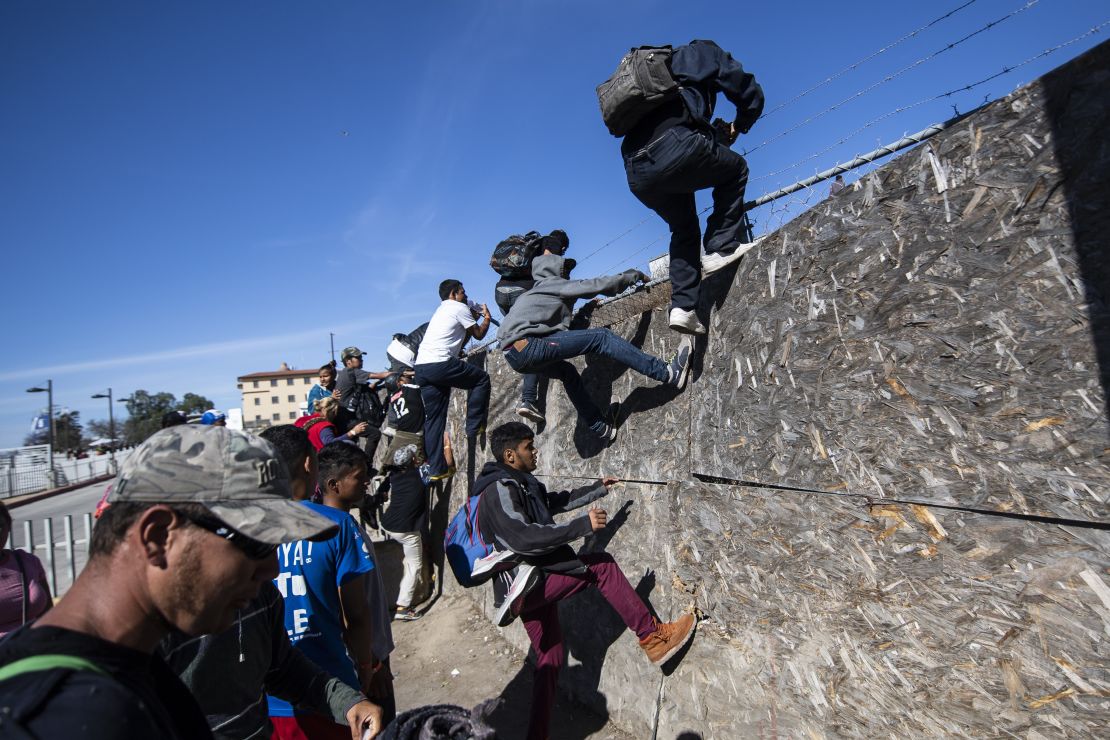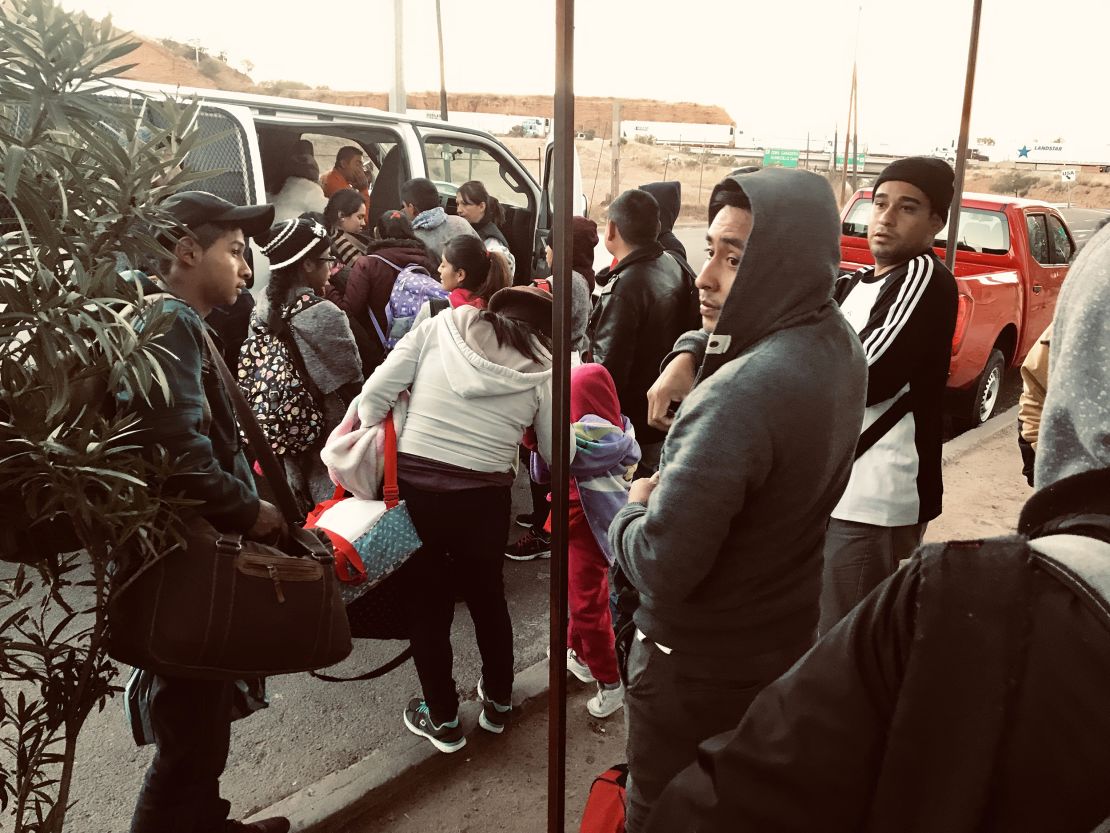As the sun dipped toward the horizon on Thursday, Kevin Ajtun, 16, hunched slightly and pulled his fake leather jacket tight. It was far colder on the US border than on the small farm he and his father had left near Mazatenango, in southern Guatemala, 22 days earlier. There, they grew beans, tobacco, corn and peanuts. An ongoing drought and low crop prices had made life hard, but it was the repeated robberies by a criminal gang of their meager earnings – “every time we sold our crops at market,” said the soft-spoken teenager – that pushed them to join the streams of migrants going north to apply for asylum in the United States.
“But now, there are so many people waiting,” he said. He and his father had been in Nogales a week, among some 150 migrants, many families with children, waiting to be allowed to make their claims.
Customs and Border Protection officials have said for months that surging asylum claims have overwhelmed ports of entry along the border. That, they say, has left them no choice but to turn back thousands of migrants, who then face waits of weeks or months. “We do not have the capacity and capability to address” the flow of asylum seekers, Department of Homeland Security Secretary Kirstjen Nielsen told the Council on Foreign Relations in November.
A September report by Homeland Security’s Office of Inspector General observed that the turnbacks and long waits are pushing asylum seekers to take the deadly risk of crossing illegally in the desert. In recent weeks, Border Patrol has apprehended what they say are unusually large groups of men, women, and children traversing the isolated areas between ports to seek asylum. On December 8, a 7-year-old Guatemalan girl named Jakelin Amei Rosmery Caal Maquin died of dehydration in Border Patrol custody after she and her father were picked up in a group of 163 migrants who’d crossed illegally near Antelope Wells, New Mexico, a particularly remote stretch of the border. Her death remains under investigation.
But critics and government watchdogs say there is little evidence that the turnbacks happen only when ports of entry are at capacity, and some believe asylum seekers like Ajtun are being held back for other reasons. The Center for Constitutional Rights, the Southern Poverty Law Center and other human-rights groups are suing DHS, arguing that “the claims of a lack of capacity are false” – part of a larger strategy by the Trump administration to keep asylum seekers out.

On Monday, the ranking Democrats on the House Judiciary and Homeland Security committees and immigration subcommittee sent a letter to CBP Commissioner Kevin McAleenan, asking him to explain comments that appear to confirm the agency is turning back asylum seekers by choice rather than out of necessity. The letter, first reported by Buzzfeed, said that at a closed December 6 briefing, acting assistant commissioner Jud Murdock told congressional staffers that DHS had chosen to limit processing at ports of entry to 100 asylum seekers a day because the “more we process, the more will come.”
CBP declined requests for an interview with Murdock, but emailed a statement that his comments “were taken out of context” and reiterated that the system had hit capacity. “As more people are processed, the capacity challenges increase, and become unsustainable. Additionally, the many advocacy organizations that help illegal aliens as they go through the immigration process, have also reached capacity. The reality is that unless Congress responds to our repeated requests for additional resources and to address pull factors for illegal immigration, we will continue to experience capacity challenges.”
On December 10, CBP for the first time released figures showing asylum claims on the southern border for the last two fiscal years. Just under 93,000 people made claims for the year ending September 30: nearly 55,000 to Border Patrol agents by people who crossed illegally, and 38,269 by people who presented themselves at ports of entry.
CBP’s 2018 figures showed a 67% increase in asylum claims along the Mexican border from the previous year, and a 121% rise at the ports of entry. But it isn’t clear why the volume either year should strain CBP’s capacity. This past year’s influx works out to an average of 105 asylum seekers a day across the entirety of the two dozen ports on the southern border. At just one port of entry, San Ysidro, on the line between Tijuana and San Diego, CBP can process up to 100 asylum seekers a day, officials have said.
That site has seen the largest backlog of migrants by far, with a queue in recent weeks of more than 5,000 people awaiting entry on the Mexican side, in often squalid conditions. Two Honduran teens staying at a migrant shelter in Tijuana were murdered on Saturday, the Honduran Foreign Ministry said. CNN crews visiting one makeshift camp in late November found hopeful asylum seekers living amid mud, open sewage, sickness, and piles of trash.
“It doesn’t seem like a number that’s outside their capacity,” said Kennji Kizuka, a senior researcher at Human Rights First, a New York-based nonprofit that sent legal monitoring teams to track asylum claims in San Ysidro and other parts of the border in November and December. “They can’t justify the restrictions they’ve placed based on these numbers.”
The government’s own watchdog reports have similarly cast doubt on the notion that the ports are at capacity. In September, a report by Homeland Security’s Office of Inspector General noted that its inspectors didn’t see severe overcrowding at CBP facilities at the entry points they had visited in prior months. However, the report also noted that inspectors “did not observe CBP turning away asylum-seekers while there was available space.”
The immigration flow can vary dramatically, of course. Caravans can bring hundreds of asylum seekers to one place over a few days. But the agency hasn’t just turned people back at isolated ports for short times during a surge. It has choked off the flow of asylum seekers into the country borderwide, with timing that suggests a more political motivation.
Along at least some parts of the border, CBP has been triaging the flow of asylum seekers since days after Trump won election, while Obama was still in office. Excerpts of internal emails obtained as part of the capacity issue lawsuit show that, as early as November 12, 2016, CBP officials advised port directors to meet with their counterparts in Mexican immigration “and request they control the flow of aliens to the port of entry.” But asylum cases for the country overall, including specifically ones that originated at ports of entry, actually went down in the fiscal year that started in fall 2016, according to US Citizenship and Immigration Services – the year in which CBP began turning people back and claiming capacity issues.
Some at CBP have pointed to ICE facilities, where asylum seekers may be moved after processing at the ports of entry and which have limited space for children and families, as a source of the bottleneck. Pete Flores, CBP’s director overseeing San Ysidro, said in a press conference last month, “The biggest challenge is ICE detention facilities, which are above capacity.” But one ICE official in San Diego told CNN that because the families are being processed and often released directly to the community, “the bed space capacity at ICE family detention facilities has no bearing on the backlog at the port of entry in San Ysidro.”
In any case, said Melissa Crow, an attorney for the Southern Poverty Law Center, the law requires the government to allow all those seeking asylum to make their claims even if their numbers have swelled. “We would never advocate that every person at the border is entitled to asylum. But the law says anyone who expresses desire to seek asylum has to be interviewed,” Crow said. “The government can’t arbitrarily decide to close the border or turn them away because there are too many of them.”
CBP officials declined repeated requests for interviews on the asylum backlog. A spokesperson provided a statement that read, in part: “The number of inadmissible individuals CBP is able to process varies based upon case complexity; available resources; medical needs; translation requirements; holding/detention space; overall port volume; and ongoing enforcement actions. No one is being denied the opportunity to make a claim of credible fear or seek asylum. CBP officers allow more people into our facilities for processing once space becomes available.”
At the port of entry in Nogales, migrants waiting on Thursday said they had seen from six to 10 people a day allowed in. Earlier this year, the port had taken as many as 20 migrants daily, said Joanna Williams, a director at the Kino Border Initiative, a Catholic nonprofit that runs some migrant services there.
“I really don’t see why they can’t maintain that pace,” Williams said. “We have had multiple days in a row this fall no one was processed at all into the port. But the numbers are not that different than in the past.”

Standing within sight of the border wall in Nogales on one evening last week, the father of one family of eight that had arrived there a day earlier seemed at once desperate and clear-eyed. Like many migrants, several of his children were coughing and sniffling from colds picked up in the crowded shelter. They had fled a small town in Guerrero, in southern Mexico, after a criminal gang dispossessed them of their farm and beat the father severely, he said. He asked that their names not be used out of fear for the family’s safety should they be forced to return.
“We had a lot of conversations about what to do,” he said, nodding at his wife. “The criminals wanted all we had – and they wanted our children to work for them. They beat me for saying no.”
What about the police? He laughed bleakly. “They’ll turn you right over.”
He’d heard about families being separated in the United States. “I’m really worried about losing the children if we get asylum,” he said. “But they will kill us if we go back.” One of his sons, 17, listening to our conversation, nodded. “We can’t go back there,” he said.
They plan to wait, as long as they must.
That, too, was the plan of Kevin and his father, Reymundo Ajtun, who had arrived in Nogales to apply for asylum a week earlier. Mexican officials stopped them short of the US port, gave them a number, and told them to wait. Kevin said he hoped their turn would come soon.
CNN’s Leyla Santiago and Geneva Sands contributed to this report.








